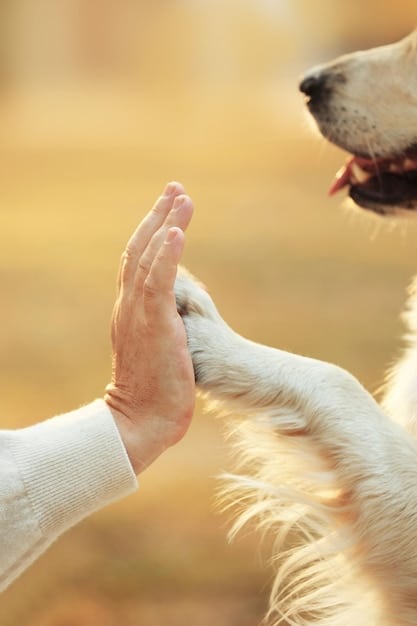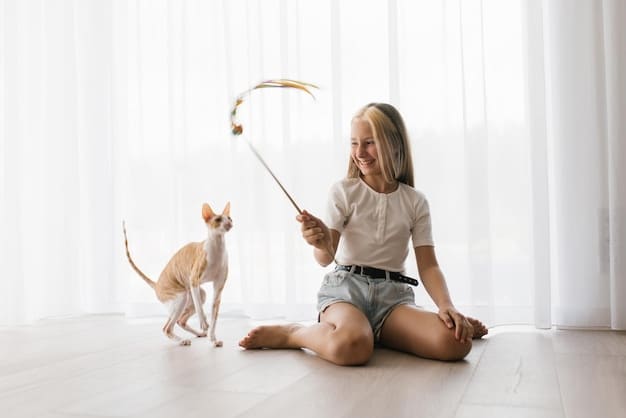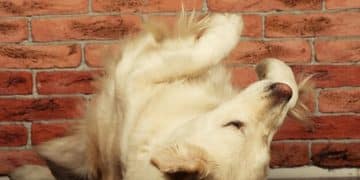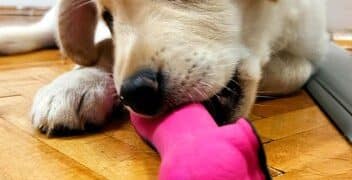Stop Puppy Biting: Gentle Training Methods for Nipping and Mouthing

Stopping puppy biting, nipping, and mouthing involves consistent, gentle training methods focused on redirection, teaching bite inhibition, and managing your puppy’s environment to minimize triggers for unwanted biting behavior.
Puppyhood is a time of playful exploration, but sometimes, those playful nips can be a bit too much. Understanding and addressing **puppy biting: how to stop nipping and mouthing with gentle training methods** is crucial for a happy, harmonious relationship with your new furry friend.
Understanding Puppy Biting
Puppy biting is a common behavior, but understanding why it happens is the first step in addressing it. It’s important to differentiate between playful nipping and aggressive biting.
Why Do Puppies Bite?
Puppies explore the world with their mouths, much like human babies use their hands. Nipping and mouthing are natural ways for them to investigate their environment and interact with littermates. These behaviors are often a part of play and socialization.
Playful Nipping vs. Aggressive Biting
It’s essential to distinguish between playful nipping and aggressive biting. Playful nipping is usually accompanied by relaxed body language, tail wagging, and a playful attitude. Aggressive biting, on the other hand, is often associated with growling, snarling, and a tense body posture.
- Play: Part of normal puppy play and exploration.
- Teething: Helps relieve discomfort as new teeth emerge.
- Communication: A way to signal boundaries with littermates and humans.
Understanding the underlying reasons for puppy biting allows for targeted and effective training strategies. By recognizing the difference between innocent exploration and potential aggression, you can approach training with the right mindset.
Teaching Bite Inhibition
Teaching bite inhibition is essential for preventing puppies from biting too hard. This process helps them learn to control the force of their bites, reducing the risk of injury.

The “Ouch!” Method
One effective method is the “ouch!” technique. When your puppy nips too hard during play, immediately say “ouch!” in a high-pitched voice. This mimics the sound a puppy would make when hurt by a littermate, signaling to your puppy that they’ve bitten too hard.
Time Outs
If the “ouch!” method doesn’t work, or if your puppy continues to bite, implement a time-out. Briefly stop playing and turn away from your puppy, or put them in a designated quiet area for a few minutes. This helps them associate biting with the end of playtime.
- Consistency: Always react the same way when your puppy bites too hard.
- Positive Reinforcement: Praise and reward your puppy when they play gently.
- Patience: Bite inhibition takes time and consistent effort.
Teaching bite inhibition is a critical aspect of puppy training, setting the stage for safe and enjoyable interactions throughout their life. Consistent application of these techniques will teach your puppy to moderate the strength of their bites.
Redirection Techniques
Redirection involves guiding your puppy’s attention away from biting and towards more appropriate behaviors. This approach helps to channel their energy and natural instincts constructively.
Offer Appropriate Chew Toys
Whenever your puppy starts nipping, redirect their attention by offering a chew toy. This provides a safe and acceptable outlet for their chewing instincts. Rotate the toys regularly to keep them interesting.
Engage in Playful Activities
Engage your puppy in playful activities that don’t involve mouthing or nipping. Fetch, tug-of-war with a soft toy, and puzzle toys can be great alternatives. Ensure that you control the game and set boundaries to prevent unwanted biting.
- Variety: Keep a variety of toys on hand to prevent boredom.
- Interactive Play: Spend time playing with your puppy to fulfill their social needs.
- Positive Association: Make sure your puppy associates the toys with fun and positive experiences.
Redirection is a proactive training method that helps to prevent biting before it starts. By providing appropriate outlets and engaging activities, you can successfully manage your puppy’s biting behavior and foster a positive relationship.

Managing the Environment
Managing your puppy’s environment can reduce the likelihood of biting incidents. This involves creating a safe and stimulating space, and understanding potential triggers that may provoke biting.
Puppy-Proofing Your Home
Ensure your home is puppy-proofed to minimize access to items they might be tempted to bite. Keep shoes, clothing, and other valuable items out of reach. Provide plenty of safe and appropriate chew toys.
Identifying Biting Triggers
Pay attention to what triggers your puppy’s biting behavior. Common triggers include overexcitement, fatigue, and being startled. Once you identify these triggers, you can take steps to manage them. For instance, if your puppy gets overly excited during playtime, take a break and calm them down before resuming.
- Safe Space: Provide a comfortable and safe space where your puppy can retreat.
- Consistent Routine: Establish a consistent daily routine for feeding, playtime, and rest.
- Supervision: Closely supervise your puppy, especially during the initial training period.
Managing the environment is a crucial aspect of preventing puppy biting. By creating a safe and stimulating space and addressing potential triggers, you can minimize unwanted biting behaviors and promote a more relaxed and enjoyable environment for both you and your puppy.
Socialization and Exposure
Proper socialization plays a key role in preventing biting issues. Exposing your puppy to various sights, sounds, people, and other animals in a controlled and positive manner helps them develop into a well-adjusted and confident dog.
Early Socialization
Begin socializing your puppy as early as possible. Between 8 and 16 weeks is a critical period for socialization. Expose them to different environments, people, and animals, always ensuring the experiences are positive and safe.
Positive Experiences
Ensure that all socialization experiences are positive. Use treats, praise, and gentle encouragement to help your puppy associate new experiences with positive emotions. Avoid overwhelming them, and allow them to approach new situations at their own pace.
- Variety: Expose your puppy to a variety of sights, sounds, people, and animals.
- Controlled Environments: Introduce new experiences gradually and in controlled environments.
- Professional Guidance: Consider attending puppy socialization classes to gain expert advice and support.
Socialization is an essential component of raising a well-behaved puppy. By providing ample opportunities for positive interactions and experiences, you can help prevent biting problems and foster a confident and friendly demeanor.
When to Seek Professional Help
While many cases of puppy biting can be managed with consistent training and socialization, some situations require professional intervention. It’s essential to recognize when biting behavior may indicate a more serious underlying issue.
Signs of Aggression
If your puppy displays signs of aggression, such as growling, snarling, or snapping, it’s crucial to seek professional help. These behaviors may indicate underlying fear, anxiety, or territorial issues that require expert intervention.
Persistent Biting
If your puppy’s biting behavior persists despite your best efforts, it may be time to consult a professional. A certified dog trainer or veterinary behaviorist can assess your puppy’s behavior and develop a tailored training plan to address the issue.
- Certified Trainers: Look for certified dog trainers with experience in addressing biting behaviors.
- Veterinary Behaviorists: Consult a veterinary behaviorist for underlying medical or behavioral issues.
- Early Intervention: Seek professional help as early as possible to prevent the behavior from escalating.
Knowing when to seek professional help is crucial for addressing persistent or aggressive biting behaviors in puppies. Early intervention can make a significant difference in preventing future problems and ensuring your puppy grows into a well-behaved and balanced adult dog.
Advanced Training Techniques
For puppies that continue to exhibit biting behaviors despite initial training efforts, advanced techniques may be necessary. These methods require patience, consistency, and a deep understanding of canine behavior.
Desensitization and Counterconditioning
Desensitization and counterconditioning can be effective for addressing biting behaviors triggered by specific stimuli or situations. Desensitization involves gradually exposing your puppy to the trigger at a low intensity, while counterconditioning involves pairing the trigger with something positive, such as treats or praise.
Behavior Adjustment Training (BAT)
Behavior Adjustment Training (BAT) is a method that focuses on teaching puppies alternative behaviors in response to triggers. It involves setting up controlled scenarios in which the puppy can practice making better choices, with positive reinforcement for desired behaviors.
- Professional Guidance: Work with a certified trainer or behaviorist experienced in advanced training techniques.
- Consistency: Implement the techniques consistently and patiently.
- Positive Reinforcement: Focus on positive reinforcement to encourage desired behaviors.
Advanced training techniques can be highly effective in addressing persistent biting issues in puppies. With the guidance of a professional and a commitment to consistent training, you can help your puppy overcome unwanted behaviors and develop into a well-adjusted companion.
| Key Point | Brief Description |
|---|---|
| 🐾 Bite Inhibition | Teaching puppies to control the force of their bites. |
| 🧸 Redirection | Offering chew toys to divert from biting. |
| 🏡 Environment Management | Creating a safe and stimulating space. |
| 🐕 Socialization | Exposing your puppy to positive experiences early. |
FAQ About Puppy Biting
▼
Puppies explore the world with their mouths, much like human babies use their hands. Biting is a normal part of their development and how they interact with their environment and littermates.
▼
Use methods such as the “ouch!” technique, redirection with toys, and time-outs. Consistency is key. Ensure everyone interacting with the puppy uses the same methods.
▼
Be concerned if the biting is aggressive, frequent, or accompanied by other aggressive behaviors like growling or snapping. Consult a professional trainer or behaviorist.
▼
Good chew toys include durable rubber toys, rope toys, and puzzle toys. Rotate them regularly to keep your puppy engaged and prevent boredom, which can lead to biting.
▼
Socialization is vital. Positive exposure to various people, animals, and environments helps your puppy become well-adjusted and less likely to bite out of fear or anxiety.
Conclusion
Addressing **puppy biting** requires a combination of understanding, patience, and consistent training. By implementing gentle methods, managing the environment, and seeking professional help when needed, you can guide your puppy toward becoming a well-behaved and loving companion.





